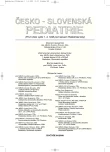Clinical Importance of Identification of PROP1 Gene Mutations in Children with Inherited Growth Hormone Deficiency
Authors:
B. Obermannová 1; J. Černá 2; V. Janštová 2; S. Koloušková 1; D. Neumann 3; D. Novotná 4; R. Pomahačová 5; J. Škvor 6; M. Šnajderová 1; Z. Šumník 1; J. Zapletalová 7; J. Lebl 1
Authors‘ workplace:
Pediatrická klinika UK 2. LF a FN Motol, Praha
přednosta prof. MUDr. J. Lebl, CSc.
1; Klinika dětského lékařství FN, Ostrava-Poruba
přednosta doc. MUDr. J. Slaný, CSc.
2; Dětská klinika FN, Hradec Králové
přednosta prof. MUDr. M. Bayer, CSc.
3; II. dětská klinika LF MU, FN Brno
přednosta prof. MUDr. Z. Doležel, CSc.
4; Dětská klinika FN, Plzeň
přednosta doc. MUDr. J. Kobr, PhD.
5; Dětská klinika, Masarykova nemocnice, Ústí nad Labem
přednosta MUDr. J. Škvor, CSc.
6; Dětská klinika FN, Olomouc
přednosta prof. MUDr. V. Mihál, CSc.
7
Published in:
Čes-slov Pediat 2009; 64 (6): 296-304.
Category:
Original Papers
Overview
Objective:
PROP1 gene is the transcription factor regulating the differentiation of anterior pituitary cells during embryologic development. Mutations found in this gene are the most frequent cause of inherited pituitary hormone deficiency in the Middle and Eastern Europe. The aim of this study was to identify the individuals with PROP1 gene mutations in the group of children with idiopathic combined pituitary hormone deficiency and with isolated growth hormone deficiency. Secondly, we evaluated clinical importance of PROP1 gene molecular genetic analysis.
Patients and methods:
We collected DNA samples and phenotypic data of 94 patients with isolated growth hormone deficiency and of 55 patients with combined pituitary hormone deficiency treated in six Czech and one foreign centre. In patients with isolated deficiency we performed a screening method to detect two most frequent PROP1 gene mutations; DNA samples of patients with combined deficiency were subjected to direct PROP1 gene sequencing.
Results:
In the group of 55 patients with combined pituitary hormone deficiency four were homozygous for 296delGA mutation; no other mutation was found in the rest of the group. In the group of 94 patients with isolated growth hormone deficiency one was heterozygous for 296delGA mutation.
Conclusions:
This study has not confirmed the clinical importance of routine identification of PROP1 gene mutations in the phenotypic heterogeneous group of patients with idiopathic isolated or combined growth hormone deficiency. It may play a role in subjects with precisely defined phenotype.
Key words:
PROP1, embryogenesis, differentiation, pituitary, transcription factor, growth hormone
Sources
1. Dattani MT, Robinson IC. The molecular basis for developmental disoders of the pituitary gland in man. Clin. Genetics 2000;57 : 337–346.
2. Dattani MT. Novel insights into the aetiology and pathogenesis of hypopituitarism. Hormone Res. 2004;62(3): 1–13.
3. Ingraham HA, Chen RP, Mangalam HJ, et al. A tissue specific transcription factor containing a homeodomain specifies a pituitary phenotype. Cell 1988;55 : 519–529.
4. Wu W, Cogan JD, Pfaffle RW, et al. Mutation in PROP1 cause familiar combined pituitary hormone deficiency. Nature Genet. 1998;18(2): 147–149.
5. Cohen LE, Radovick S. Molecular basis of CPHD. Endocrine Rev. 2002;23(4): 431–442.
6. Dattani MT. Growth hormone deficiency and combined pituitary hormone deficiency: does the genotype matter? Clin. Endocrinol. 2005;63 : 121–130.
7. Mullis PE. Genetic control of growth. Eur. J. Endocrinol. 2005;152 : 11–31.
8. Lebl J, Zapletalová J, Koloušková S, et al. Dětská endokrinologie. 1. vyd. Praha: Galén, 2004.
9. Tajima T, Ohtake A, Hoshino M, et al. OTX2 loss of function mutation causes anophthalmia and combined pituitary hormone deficiency with a small anterior and ectopic posterior pituitary. J. Clin. Endocrinol. Metab. 2009;94(1): 314–319.
10. Dattani MT, Preece M. Growth hormone deficiency and releated disorders: insights into causation, diagnosis and treatment. Lancet 2004;363(6): 1997–1985.
11. Jacobson EM, Li P, Leon-del RA, et al. Structure of Pit-1 POU domain bound to DNA as a dimer: unexpected arrangement and flexibility. Genes Dev. 1997;11 : 198–212.
12. Duquesnoy P, Roy A, Dastot F, et al. Human Prop-1: cloning, mapping, genomic structure: mutations in familial combined pituitary hormone deficiency. FEBS Lett. 1998;437 : 216–220.
13. Lebl J, Vosáhlo J, Pfaeffle RW, et al. Auxological and endocrine phenotype in a population-based cohort of patients with PROP1 gene defects. Eur. J. Endocrinol. 2005;153 : 389–396.
14. Deladoey J, Fluck C, Buyukgebiz A, et al. „Hot Spot“ in the PROP1 gene responsible for combined pituitary hormone deficiency. J. Clin. Endocrinol. Metab. 1999;84 : 1645–1650.
15. Agarwal G, Bhatia V, Cook S, et al. Adrenocorticotropin deficiency in combined pituitary hormone deficiency patients homozygous for a novel PROP1 deletion. J. Clin. Endocrinol. Metab. 2000;85 : 4556–4561.
16. Mendonca BB, Osorio MGF, Latronico AC, et al. Longitudinal hormonal and pituitary imaging changes in two females with combined pituitary hormone deficiency due to deletion of A301,G302 in the PROP1 gene. J. Clin. Endocrinol. Metab. 1999;84 : 942–945.
17. Reynaud R, Magali G, Alexandru S, et al. Genetic screening of combined pituitary hormone deficiency: experience in 195 patients. J. Clin. Endocrinol. Metab. 2006;91(9): 3329–3336.
18. Turton JP, Mehta A, Raza J, et al. Mutations within the transcription factor PROP1 are rare in a cohort of patients with sporadic combined pituitary hormone deficiency (CPHD). Clin. Endocrinol. (Oxf.) 2005;63(1): 10–18.
19. Ward RD, Davis SW, Cho M, et al. Comparative genomics reveals functional transcriptional control sequences in the Prop1 gene. Mamm. Genome 2007;18(6–7): 521–537.
Labels
Neonatology Paediatrics General practitioner for children and adolescentsArticle was published in
Czech-Slovak Pediatrics

2009 Issue 6
Most read in this issue
- Corticosteroids and Azathioprine in the First Year of Crohn Disease Therapy in Children
- Inhaled Nitric Oxide in Treatment of Severe Respiratory Failure in Children
- Clinical Importance of Identification of PROP1 Gene Mutations in Children with Inherited Growth Hormone Deficiency
